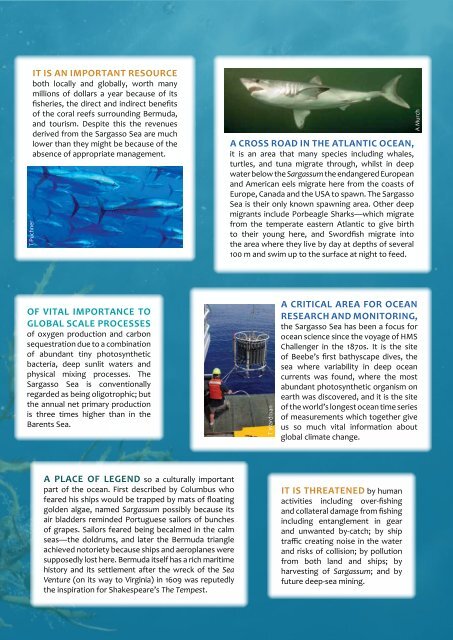Sargasso Sea Facts - Convention on Biological Diversity
Sargasso Sea Facts - Convention on Biological Diversity
Sargasso Sea Facts - Convention on Biological Diversity
You also want an ePaper? Increase the reach of your titles
YUMPU automatically turns print PDFs into web optimized ePapers that Google loves.
T PuchnerIt is an important resourceboth locally and globally, worth manymilli<strong>on</strong>s of dollars a year because of itsfisheries, the direct and indirect benefitsof the coral reefs surrounding Bermuda,and tourism. Despite this the revenuesderived from the <str<strong>on</strong>g>Sargasso</str<strong>on</strong>g> <str<strong>on</strong>g>Sea</str<strong>on</strong>g> are muchlower than they might be because of theabsence of appropriate management.A cross road in the Atlantic Ocean,it is an area that many species including whales,turtles, and tuna migrate through, whilst in deepwater below the Sargassum the endangered Europeanand American eels migrate here from the coasts ofEurope, Canada and the USA to spawn. The <str<strong>on</strong>g>Sargasso</str<strong>on</strong>g><str<strong>on</strong>g>Sea</str<strong>on</strong>g> is their <strong>on</strong>ly known spawning area. Other deepmigrants include Porbeagle Sharks—which migratefrom the temperate eastern Atlantic to give birthto their young here, and Swordfish migrate intothe area where they live by day at depths of several100 m and swim up to the surface at night to feed.A MurchOf vital importance toglobal scale processesof oxygen producti<strong>on</strong> and carb<strong>on</strong>sequestrati<strong>on</strong> due to a combinati<strong>on</strong>of abundant tiny photosyntheticbacteria, deep sunlit waters andphysical mixing processes. The<str<strong>on</strong>g>Sargasso</str<strong>on</strong>g> <str<strong>on</strong>g>Sea</str<strong>on</strong>g> is c<strong>on</strong>venti<strong>on</strong>allyregarded as being oligotrophic; butthe annual net primary producti<strong>on</strong>is three times higher than in theBarents <str<strong>on</strong>g>Sea</str<strong>on</strong>g>.T WardmanA critical area for oceanresearch and m<strong>on</strong>itoring,the <str<strong>on</strong>g>Sargasso</str<strong>on</strong>g> <str<strong>on</strong>g>Sea</str<strong>on</strong>g> has been a focus forocean science since the voyage of HMSChallenger in the 1870s. It is the siteof Beebe’s first bathyscape dives, thesea where variability in deep oceancurrents was found, where the mostabundant photosynthetic organism <strong>on</strong>earth was discovered, and it is the siteof the world’s l<strong>on</strong>gest ocean time seriesof measurements which together giveus so much vital informati<strong>on</strong> aboutglobal climate change.A place of legend so a culturally importantpart of the ocean. First described by Columbus whofeared his ships would be trapped by mats of floatinggolden algae, named Sargassum possibly because itsair bladders reminded Portuguese sailors of bunchesof grapes. Sailors feared being becalmed in the calmseas—the doldrums, and later the Bermuda triangleachieved notoriety because ships and aeroplanes weresupposedly lost here. Bermuda itself has a rich maritimehistory and its settlement after the wreck of the <str<strong>on</strong>g>Sea</str<strong>on</strong>g>Venture (<strong>on</strong> its way to Virginia) in 1609 was reputedlythe inspirati<strong>on</strong> for Shakespeare’s The Tempest.It is threatened by humanactivities including over-fishingand collateral damage from fishingincluding entanglement in gearand unwanted by-catch; by shiptraffic creating noise in the waterand risks of collisi<strong>on</strong>; by polluti<strong>on</strong>from both land and ships; byharvesting of Sargassum; and byfuture deep-sea mining.


